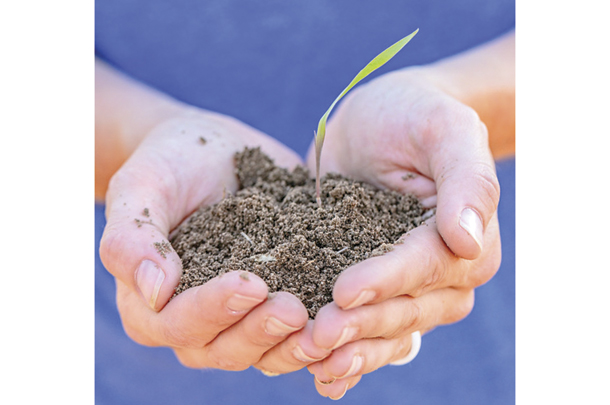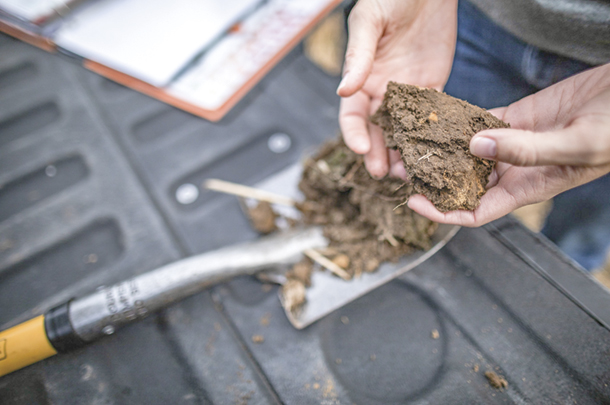With current market incentives to increase crop yields and doing whatever it takes to boost those yields, building soil organic matter can sometimes takes a backseat on farms.
But it doesn’t have to according to university experts and farmers who are taking the matter seriously. There is good reason to pay attention to it. Organic matter is an important component of soil health, nutrient cycling and crop productivity. By managing soil organic matter, producers can go a long way toward improving crop performance.
For some farmers, improving soil health is high on the priority list. Dan DeSutter, a crop farmer from Attica, Indiana, made the decision about four years ago to forego the “higher yields at all costs” way of thinking by converting his 5,000-acre farm to organic production. He is still in the transition phase but believes he can eventually build his yields to close to what they were with conventional production methods.
“Yield is not our primary focus – our primary goal is regenerating soil,” DeSutter said. “If it doesn’t pay this year or next year, it will somewhere down the line. That’s a different mindset.”
DeSutter employs cover crops and cultivation to help build organic matter and improve soil health.
In 2020, some of his organic corn fields yielded as high as 240 bushels per acre.

By managing soil organic matter, producers can go a long way toward improving crop performance.
“When you build the organic matter in soil, there are bacteria in the soil that can pull nitrogen out of the air and make it plant-available,” DeSutter said. “We’re still in the [research and development] phase of this, but we’ve seen enough to know that what we want to do is doable. We’re building organic matter, and the soil is going to get better with time.”
DeSutter also appreciates the premiums for growing organic crops. “I don’t expect those [organic] premiums are going to stay around forever, but I hope they stay around long enough to get our soils working for us again,” he said.
Stefan Gailans, research and field crops director at Practical Farmers of Iowa, said by using cover crops in conjunction with corn and soybeans, farmers can not only improve soil health, but they can also make better use of rainfall and available soil moisture.
“Improved soil health helps increase productivity and reduces volatility on the farm,” Gailans said. “We’ve seen situations where farms with healthy soil have a better tolerance of drought and flooding, and they see that their corn isn’t drying up in August or September because they’ve had good water penetration into the soil that the crop can access.
“Farmers are also seeing less erosion in their fields when we have some of these nasty gully washers, because they’ve improved the physical structure of their soils. There is scientific literature that the structural characteristics of soil improve with the longer use of cover crops.”
The largest component of soil organic matter, organic carbon, is often considered the basis of sustainable agriculture. Approximately 58% of the mass of soil organic matter exists as carbon. Some of the forms of carbon are used by soil organisms for energy, and other forms are resistant to change for decades.

The best way to determine if you are doing enough to manage fertility and improve organic matter in the soil is by taking soil samples.
Experts say that by increasing the amount of carbon stored in the soil, farmers can significantly offset the amount of carbon dioxide in the atmosphere while improving the health of the soil – something we’ve been hearing a lot about through carbon credits.
A 6-inch-deep layer of soil that has 3% organic matter contains 17 tons of carbon per acre. Increasing the organic matter content to 4% would capture an additional 5.8 tons of carbon or the equivalent of 21 tons of carbon dioxide in 1 acre of soil.
Carbon stored in the soil is not a plant nutrient, but it has significant influence on the availability of plant nutrients and soil qualities. The balance of carbon to nitrogen is especially important.
Carrie Laboski, a professor in the University of Wisconsin – Madison Soil Science Department, said nitrogen is the soil nutrient that most often limits crop yields. Inputs of nitrogen into the soil come from crop residues, manure, fixation from legumes and fertilizer applications. Losses include leaching, denitrification and plant uptake.

Carbon stored in the soil is not a plant nutrient, but it has significant influence on the availability of plant nutrients and soil qualities. Photos courtesy of VAS.
When the amount of nitrogen in the soil is deficient, plants will start cannibalizing themselves, Laboski said, and yields are almost certain to take a hit.
University researchers from across the Midwest collaborated to develop a nitrogen fertilizer rate calculator to help farmers predict how much fertilizer they need to add to their soil to reach their production and economic goals. This “Corn Nitrogen Rate Calculator” is based on regional yield trials and the prices farmers expect to pay for nitrogen and receive for their crop. From this, an economically optimum rate is calculated.
However, the best way for farmers to determine if they are doing enough to manage fertility and improve organic matter in their soil is by taking soil samples.
John Sawyer, a former professor in the Iowa State University Agronomy Department, said there are two basic soil tests to help farmers learn how much nitrogen they have in their soil – the pre-plant soil nitrate test and the pre-sidedress soil nitrate test. Both measure soluble nitrogen in the soil before applying needed fertilizer, which allows a farmer to adjust application rates to account for available nitrogen in the root zone.
But Sawyer said soil testing laboratories often rely on measuring carbon with the organic matter test to estimate the nitrogen that will be available from the soil. Steve Culman, an assistant professor and state specialist in soil fertility of the School of Environment and Natural Resources at Ohio State University, said in his research, carbon mineralization was the best predictor of agronomic performance both individually and when modeled with multiple indicators. His research demonstrates that measuring the rate that carbon is mineralized is an inexpensive but good predictor of soil fertility and corn agronomic performance.
Carbon mineralization is measured by capturing the carbon dioxide released from organisms respiring in a moist soil sample placed in an incubator. Knowing the amount of nitrogen and carbon in the soil is good, but to improve the management of the soil and crop, it helps to know how they work together to improve yield.
Jim Friedericks, director of outreach and education for VAS Laboratories, said it is the combination of nitrogen with organic carbon, and how they interact, that provides the benefits important to soil health. Respiration of organic carbon by soil organisms releases nitrogen from organic matter into the soil and makes it available to plant roots. When soil carbon levels and respiration rates are high, the release of nitrogen is also higher and results in better yields.
Friedericks said anything that farmers can do to boost the amount of organic matter in their soil can help them provide nitrogen for their crops.
Healthy soil not only promotes higher yields and crop health but also promotes carbon sequestration and water retention – something that many experts believe will be part of mitigating climate change.
PHOTOS: Photos courtesy of VAS.










